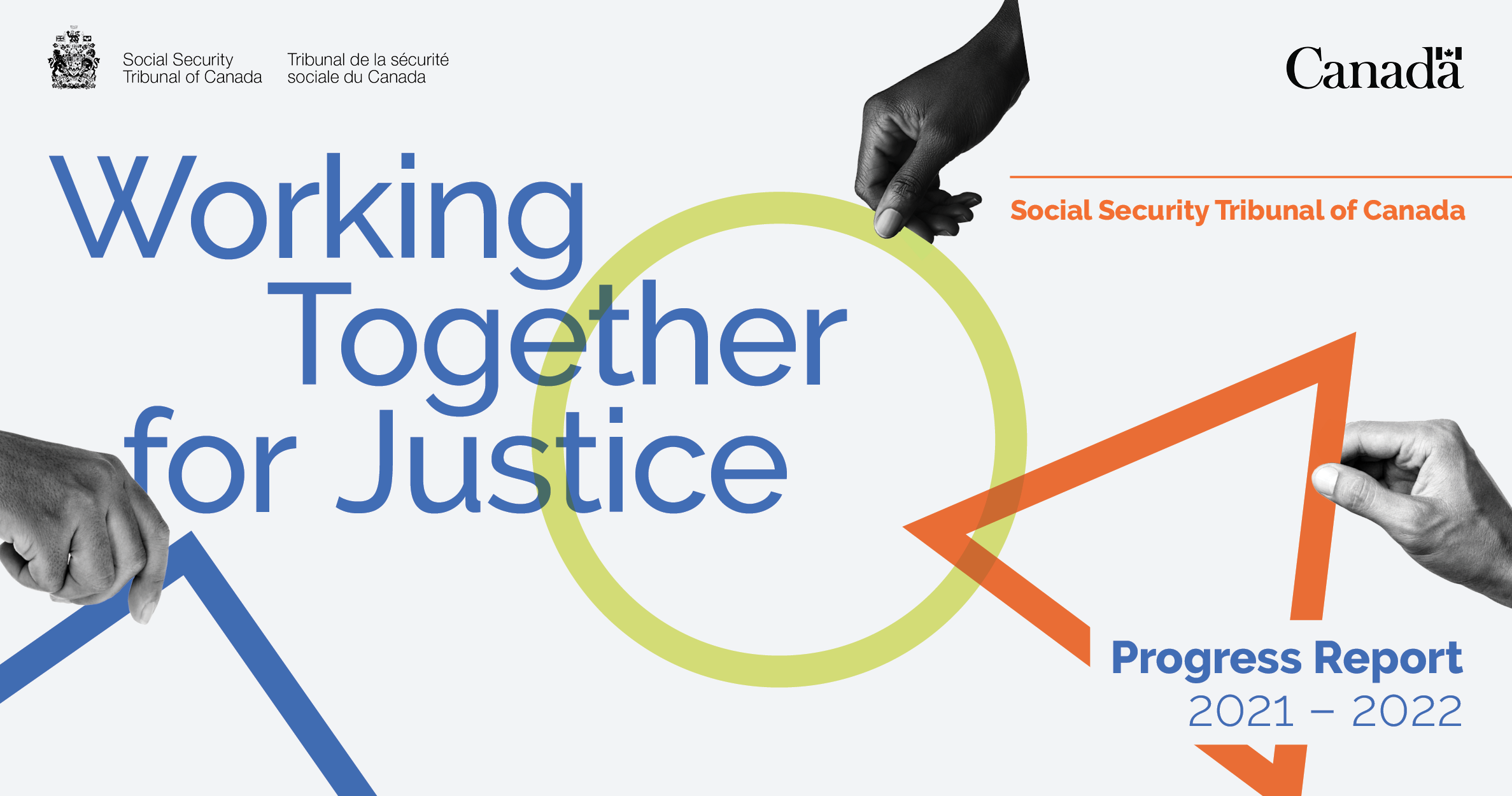
On this page
- Word from the Chairperson and Executive Director
- Land Acknowledgement
- Social Security Tribunal
- By the Numbers
- Part 2: Service Standards and Processing Times
- General Division – Employment Insurance (excludes group appeals)
- General Division – Income Security
- Appeal Division (excludes Employment Insurance group appeals)

We wrote and published this report in Ottawa, the traditional unceded territory of the Algonquin Anishnaabeg people.
We understand we’re part of a larger conversation about reconciliation. In 2021, we began to explore what truth and reconciliation mean in what we do at our tribunal. We now have a group at the SST looking at barriers to justice that Indigenous people may face. This group is working with us to make our processes better. Our goal is to find ways to take part in reconciliation in a meaningful way.
People will be reading this report in many places across Canada. These will include other traditional Indigenous lands. We invite you to learn more about these communities.

The SST decides appeals about whether you can get these benefits
- Employment Insurance
- Canada Pension Plan (CPP) disability and other CPP benefits
- Old Age Security
Our federal social support system is built on these benefits. Anyone who qualifies can get them to help meet their basic needs. The SST gives you the opportunity to challenge a government decision about whether you qualify.

We processed 5,115 appeals
GD-IS: 2,096; AD-IS: 165; GD-EI: 2,582; AD-EI: 272
We sent 13% of appeals for alternative dispute resolution (ADR) at the Appeal Division
82% of ADR appeals were resolved without a hearing
Navigators worked on 2,465 appeals, helping under-represented appellants
We published 1,056 decisions on our website
95% of clients were satisfied overall from over 1,200 survey responses. This is 3% higher than last year.
94% of clients said they knew what to expect and how to prepare for their hearings. 97% of clients said they were able to participate fully in their hearings

We have a new website
We’re always looking for ways to improve our content so we can serve you better. We did user testing on our old website. People had a hard time navigating through it and finding what they needed. Using what you told us, we created and launched a new website .
The new website:
- has less text and more images
- is written in plain language
- is focused on our appellants’ needs
Our client satisfaction survey results from January to March 2022 show promising feedback to our website. Of the respondents who had visited our website, 95% were able to find what they were looking for.
We still have work to do. People want more visual content and infographics. We’ll add these.
Our website also now has a glossary of legal terms we sometimes use.
The laws that set out whether you have a right to benefits are very technical. And sometimes, we have to use the complicated terms the laws use. But we can always explain what these terms mean in a way that’s easy to understand. Our glossary has our top 50 complex terms. We hope it will help you understand the language:
- on our website
- in our decisions
- in our forms and letters
We want to keep hearing from you about how the website. Contact us to tell us what you think.
We’re getting good results from our early resolution pilot project
Appeals can take time. But some can be resolved quickly and even without a hearing. That’s why we started the early resolution pilot project for the General Division – Income Security Section. With early resolution, a member (decision-maker) meets with the parties early in the appeal process. The goal is to see whether we can resolve the appeal quickly.

After 1 year, here’s what we know:
- On average, appeals that go through the pilot project are heard sooner and resolved faster than other appeals
- Appellants are better prepared for their hearings
- Appellants tell us they feel heard and are thankful for the opportunity to talk about their appeals with a member
- Appellants better understand what we can and can’t do for them, and what their role in the process is
We’ll keep working on this project to see whether we can use it for more appeals. We expect to see the results from a wider sample of appeals next year.
We got an outside perspective
Our forms and letters

If you have an appeal at the SST, you need to be able to understand our forms and letters. We rewrote them in plain language. But we wanted an outside perspective on our work. So we asked the National Self‑Represented Litigants Project (NSRLP) to evaluate how we’re doing.
The NSRLP talked to people who had represented themselves in courts and tribunals and asked them to review forms and letters that the SST sends to claimants. They gave us detailed feedback on our work.
Overall, people say our letters and forms explain legal language and complex terms well. They also like how we structured and organized information. But many didn’t know how to complete parts of the forms. And they still had questions about what they were supposed to do, even after reading the forms and letters.
The NSRLP gave us some recommendations. They said people want:
- clearer instructions in our letters and forms
- a friendlier tone in our letters
- more visual content (like flow charts, infographics, and short videos)
- more explanations of what some terms mean
We thank the NSRLP for this valuable input! We have an action plan and are already starting to making changes. Read more about the NSRLP evaluation on our website.
Our January to March 2022 client satisfaction survey results show that we’ve made progress since this evaluation. 98% of respondents said they knew what to expect and how to prepare for their hearings.

Reaching out to help keep us accountable
The SST is responsible for handling appeals in a way that is simple, quick, and fair. But we don’t do it alone. Our partners have a lot of insight into what works, or doesn’t work, for our appellants. Our partners include:
- legal clinics
- lawyers
- paralegals
- unions
- advocacy groups
We meet with our partners regularly to share ideas and hear what they have to say. This year, we held 4 sessions through our consultative committees to meet with our partners. Read more about our Employment Insurance Appeals Consultative Committee and our Income Security Appeals Consultative Committee on our website.
We also had special sessions to talk about our upcoming new rules of procedure. We got a lot of useful advice on how they should work. Our website sums up what we heard and what we plan to do.
Working with you is important to building a better administrative justice system. This year, we created an outreach team to do exactly that.
If you’re interested in joining our community of partners or want an information session for your organization, let us know. Contact our outreach team at:

Explaining how we work
The federal courts can assess the reasonableness of Appeal Division decisions. They look at whether our decisions are based on a logical chain of reasoning and make sense in light of the law and facts. They do this through a process called judicial review. Judicial review is how the courts make sure we’re following the rules.
The Supreme Court of Canada (SCC) said that the courts have to use the reasonableness standard of review when assessing most tribunal decisions, with some exceptions. The SCC confirmed this in a case from 2019 called Canada (Minister of Citizenship and Immigration) v Vavilov (Vavilov).
In the Vavilov decision, the SCC said that it’s important to understand the context in which a tribunal works to decide whether a tribunal decision is reasonable. That’s why we developed How the Social Security Tribunal (SST) works: Responding to the Supreme Court of Canada’s decision in Vavilov. This information is meant to inform courts, parties who want to challenge our decisions in the courts, and the public about the context we work in.

What we’re doing next
We keep looking for ways to serve you better. And we use your feedback to help us make the right changes. Going forward, one of our top priorities is to make sure people have the information they need to understand the appeal process. To do this, we’re developing new tools to meet the different needs of the people who appeal to the SST.
Here’s a look at our upcoming projects:
- We’ll have information sessions for community justice organizations to explain the appeal process and what resources we have for appellants
- Our website will have roadmaps (printable infographics) on the processes for Employment Insurance and Income Security appeals
- We’re working with Community Legal Education Ontario to make an online guided
pathway for people applying for CPP disability
- The pathway will guide them through filling in their notice of appeal form
- When they’re done, the pathway will generate a completed form
- We’re giving appellants a new way to file their appeals: using their My Service Canada Account
- We’ll be developing a plan to help us meet our commitment to fairness, diversity, and inclusion
We look forward to updating our partners and the public as these important initiatives take shape.
For most people, going through a legal process is stressful. For our appellants, a lot of the stress comes from waiting—waiting for a hearing, then for a decision. We need to be quick, but we also can’t cut corners to rush things. Our goal is to make quality decisions as quickly as possible. That’s why we publish statistics that measure our work. It helps us stay accountable to the people who use our service.
The numbers below are the most recent numbers from each fiscal (financial) year.
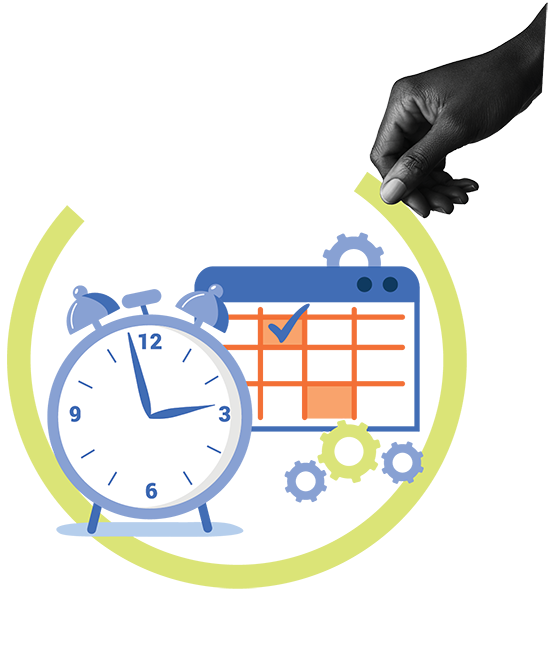
Inventory
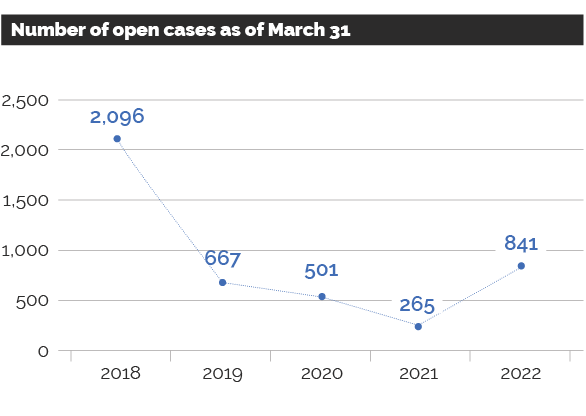
Graph showing the inventory for the number of open cases as of March 31 from 2018 to 2022. There were 2,096 appeals in 2018, 667 appeals in 2019, 501 appeals in 2020, 265 appeals in 2021, and 841 appeals in 2022.
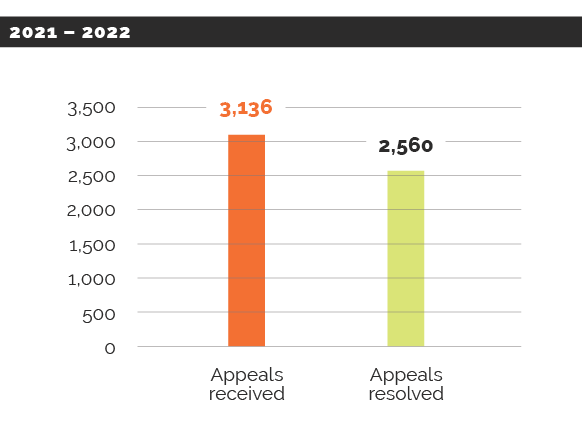
Graph showing the inventory for General Division – Employment Insurance appeals (excluding group appeals) from April 1, 2021 to March 31, 2022. 3,136 appeals were received and 2,560 appeals were resolved.
Processing Times
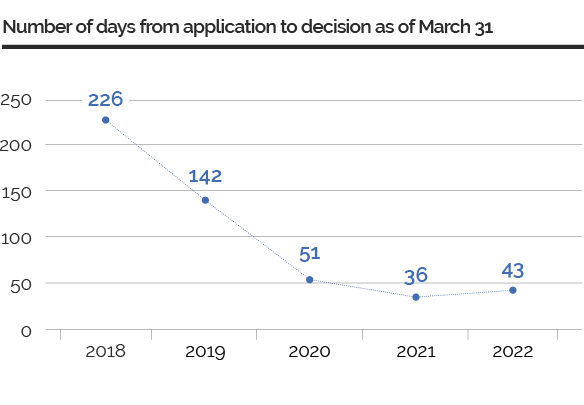
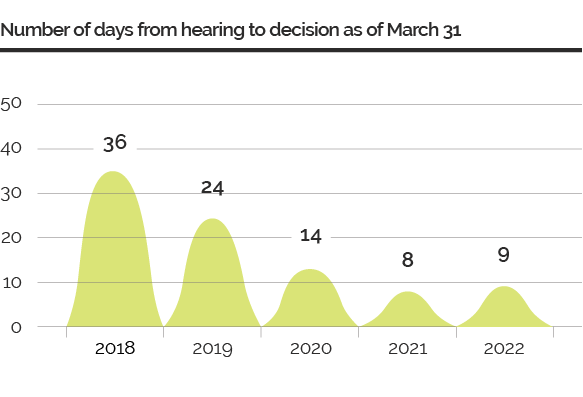
Service Standards
We almost met our service standard goals.
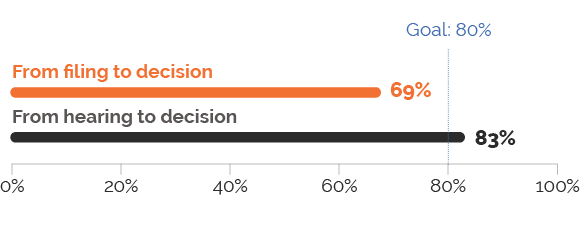
This year, we wanted to give appellants their decisions within 45 days of when they filed their appeals and within 15 days of their hearings. We wanted to do this at least 80% of the time.
We met our 15-day goal, but not our 45-day goal.Our average time was 42.9 days from filing to decision and 9.0 days from hearing to decision.
General Division Employment Insurance Appeal Origin
This year, 99% of appeals (3,213) came from claimants and 1% (21) from employers.
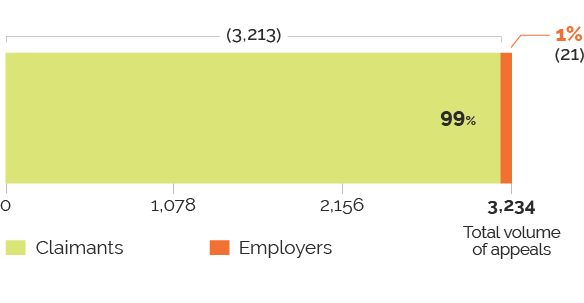
Inventory
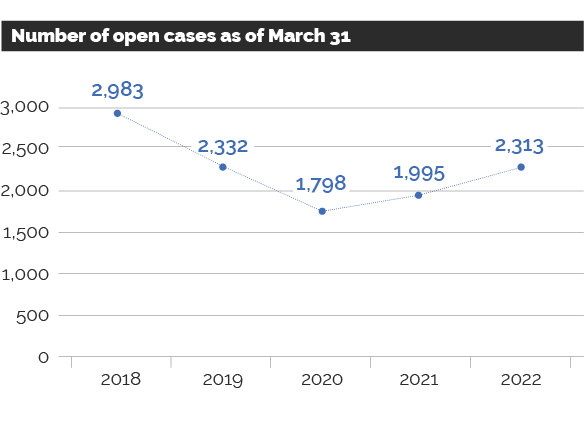
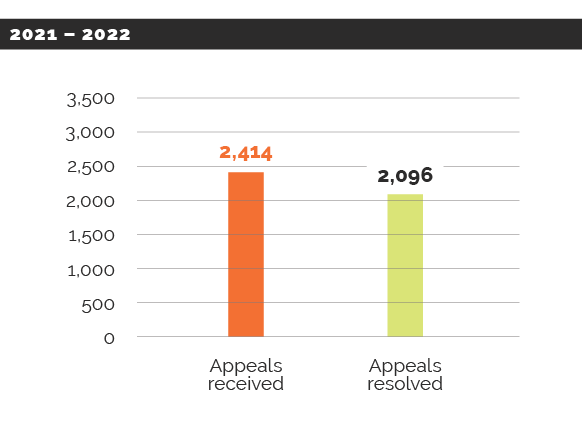
Processing Times
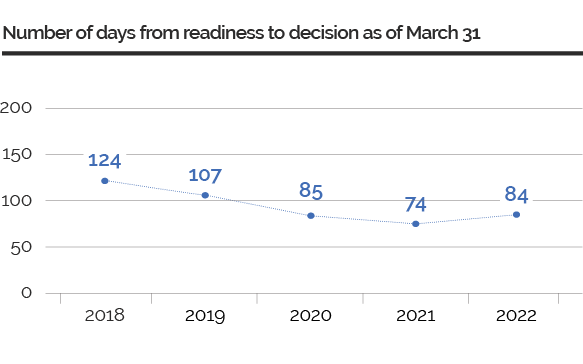
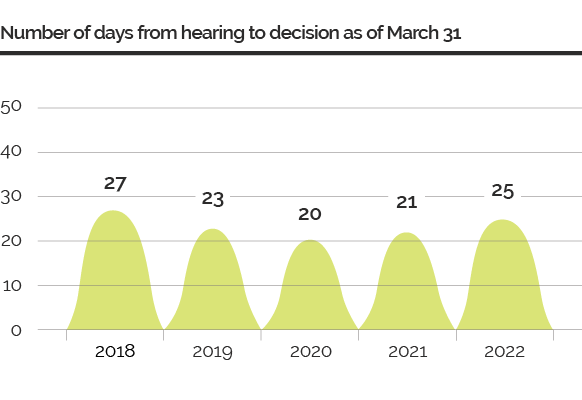
Service Standards
We didn’t meet our service standard goals.
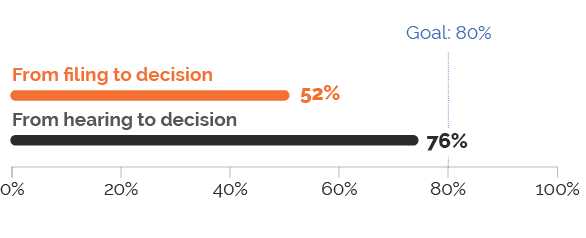
We didn’t meet our goals. Our average time was 83.9 days from filing to decision and 25.1 days from hearing to decision. We met our service standard 52% of the time from filing to decision, and 76% of the time from hearing to decision.
Inventory
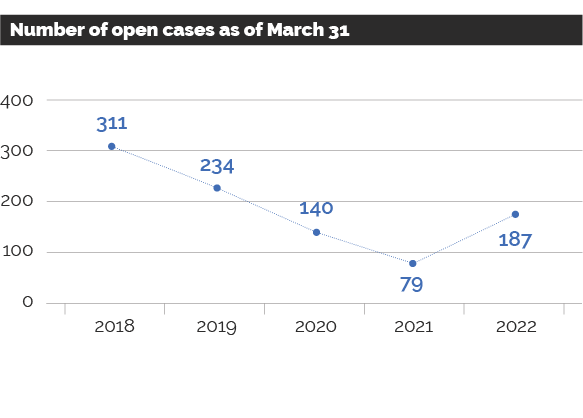
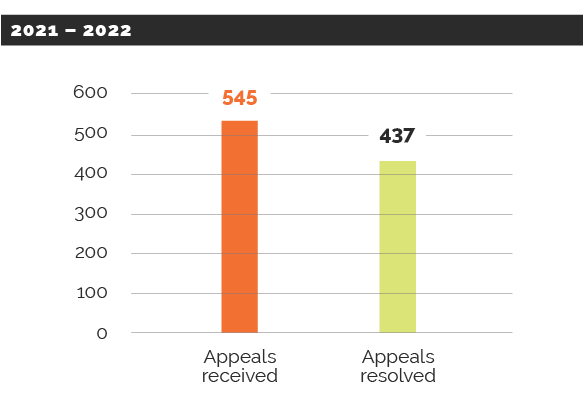
Processing Times
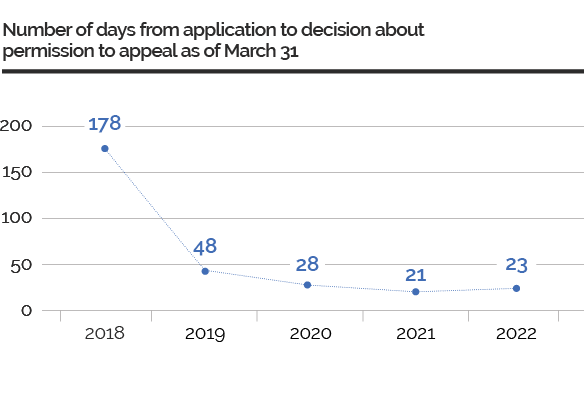
At the Appeal Division this year, the number of appeals waiting to be heard has gone up, but we have continued to serve you quickly.
Graph showing the number of days from application to decision about permission to appeal as of March 31 from 2018 to 2022. The processing times are as follows: 178 days in 2018, 48 days in 2019, 28 days in 2020, 21 days in 2021, and 23 days in 2022.
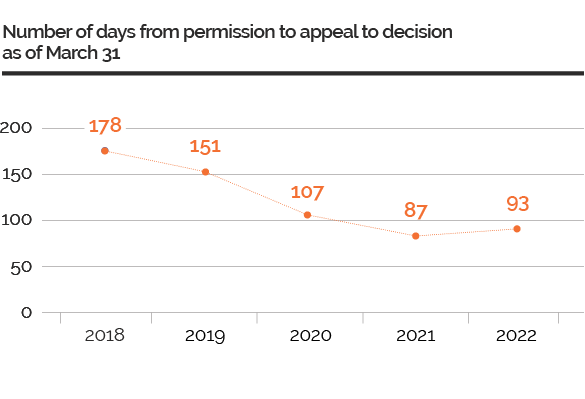
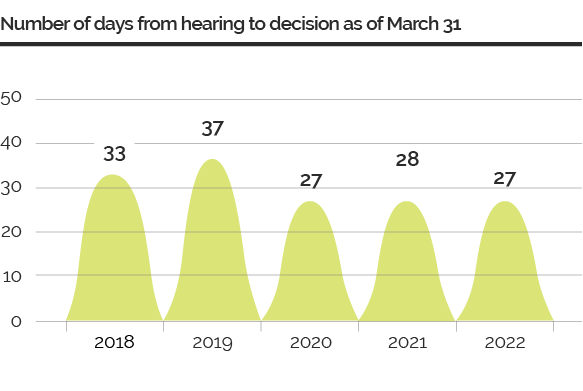
Service Standards
We did better than our service standard goals.
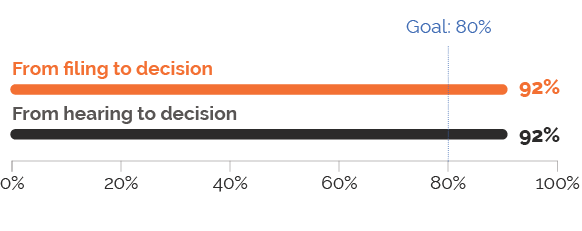
This year, we wanted to give appellants their decisions about permission to appeal within 45 days of when they filed their appeals. And we wanted to make a final decision within 150 days of giving them permission to appeal. We wanted to do this at least 80% of the time.
We did better than our goals! Our average time to give permission to appeal was 23.1 days. And our average time to make a final decision was 93.1 days.
Appeal Division – Income Security & Employment Insurance
For Income Security appeals, 151 appeals came from claimants, 17 came from the Minister of Employment and Social Development, and 4 came from Added Parties. For Employment Insurance appeals, 244 appeals came from claimants, 123 came from the Canada Employment Insurance Commission, and 6 came from Employers.
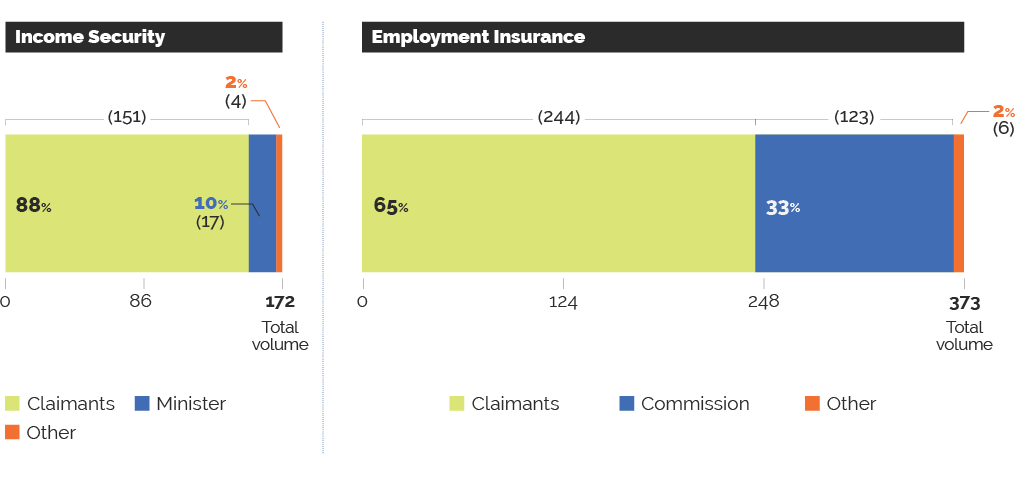
Graph showing who filed the appeal at the Appeal Division – Income Security section. 88% of appeals, which amounted to 151 appeals, were from applicants. 10% of appeals, which amounted to 17 appeals, were from the minister. 2% of appeals, which amounted to 4 appeals, were from other.
Graph showing who filed the appeal at the Appeal Division – Employment Insurance section. 65% of appeals, which amounted to 244 appeals, were from claimants. 33% of appeals, which amounted to 123 appeals, were from the commission. 2% of appeals, which amounted to 6 appeals, were from the employer.


